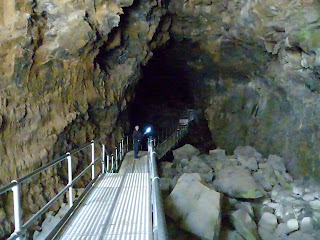Painted Hills is the 3rd unit of John Day Fossil Beds National Monument. We went to the Clarno Unit in 2010, and the Sheep Rock Unit a couple days ago. Today we headed west on US 26, The Journey Through
Time Scenic Byway. George wasn’t happy about backtracking 50 miles, but he wouldn't have been interested in
dragging the trailer through here. Since I’d blown that suggestion at the Clarno Unit, I just kept my mouth shut.
The Painted Hills are one of the “Seven Wonders of Oregon”. (The others are Crater Lake, Smith Rock, Wallowas, Mount Hood, Columbia River
Gorge and the Oregon Coast. We’ve been
to Crater Lake, the Gorge and the Coast--maybe someday I’ll work the rest in.) The entrance is a little understated. Many of the hills along Bridge Creek are just
that...ordinary hills. 

Along Burnt Ranch Road, the hills started to show signs of color.
There’s no visitor center (the one at Sheep Rock serves all
three units, probably because Clarno and Painted Hills aren’t as accessible and
don’t get as many visitors.) There’s a
little picnic area with an office or something for the ranger, but it was
closed when we got there. I already had
maps of the trails. All roads in the
park are gravel, but in decent condition.
The colors change in the light, with shades of red and yellow
contrasting with browns and tans on the hills.
You look, take a picture, point the camera somewhere else, look back and
zoom—and it’s different. Sometimes the
colors almost bleed.
Up close, this:
Becomes this:

We skipped the steep climb up the Carroll Rim Trail, and chose
the shorter Painted Hills Overlook Trail on the other side of the road. Since we’re both 70 now (or very close to
it!), we’re opting for the shorter hikes instead of the longer ones. Actually, we never did go on the really long
ones...

Next up was Painted Cove, where the trail winds around a
little hill, part of it on a boardwalk so the soil isn’t disturbed. Depending
on the light and the angle, the colors change as you move. The reds are from
iron oxide (think rust!) and range from brick to merlot. The yellows and
oranges are a blend of iron and magnesium oxides, and vary from ochre to Dijon. If you’re in the right mood, you can identify
lavenders from rhyolitic lava. (Yes, I copied the mineral stuff from a
sign. Most of you would too!)


Even the lichen on the rocks comes in cool colors:

The hill is made of claystone, which looks like dried cracked
mud. One of the info signs says the hill
is 33 million years old. Seriously? The hillsides
erode after big thunderstorms, leaving miniature canyons where the slurries of clay run off, draining off bits of the hill every time it rains. I cannot believe that a hill so delicate
could have possibly lasted 33 million years!
You’re not supposed to walk on the hills because they cause even more
erosion. They certainly leave ugly trails. If the hills are 33 million years old, then the original size must have been mind-boggling.


You can see the boardwalk around the hillside here. I like the way that sometimes the colors are aloof and distinct, and sometimes are friendly and mingle.

Next up was Leaf Hill Trail, a loop around a Leaf Hill where
lots of fossils of leaves from hardwood forests were found. They were pressed like flowers in the ashy
lake sediments, and later turned to shale.
The hill is unprepossessing, even off-putting, reminding me of a pile of broken oyster shells. The trail goes around the unappealing mound
next to me, not the colorful stuff in the background. (The last picture is a closeup of the pieces of broken shale on the hill.)


The last trail seems to have an identify crisis, variously
called Red Scar Knoll Trail and Red Hill Trail. (I’ll go with the more
descriptive name rather than the plain one.) The white on the hill behind
the parking lot is from volcanic ash, which of course, you already knew...
The hill is definitely RED! And the other's really yellow!

Which unit of John Day Fossil Beds do I like best? This one.
I tend to go for the splashy “Wow!” in nature. And these painted hills have a lot of that.
Here's the link to more pictures on Flickr: John Day - Painted Hills




















































